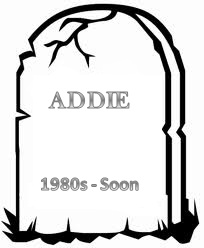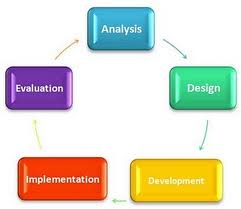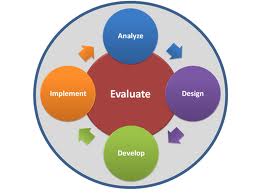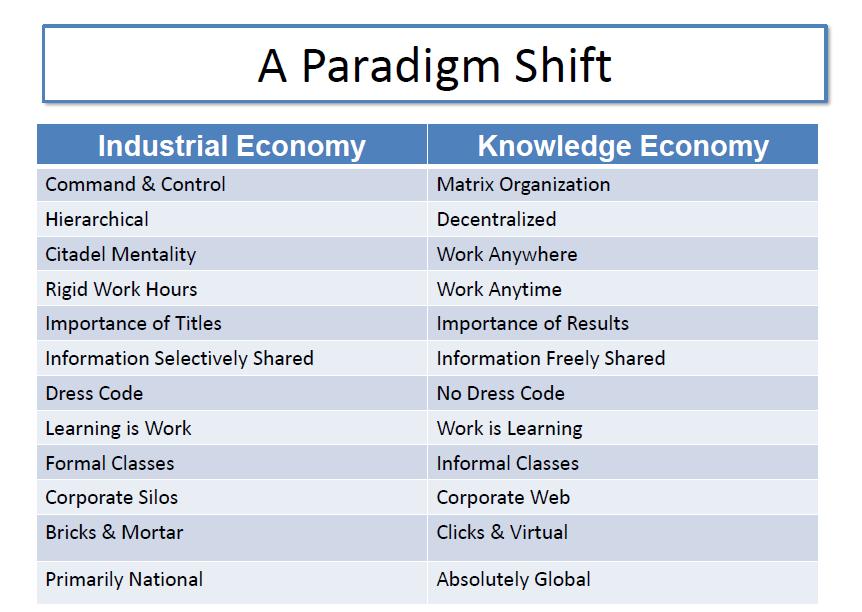NOTE (October, 2012): I first posted this piece in 2004. At the time I was looking at educational theories and methods that had been developed in the early 1970’s and that rather mysteriously became the de facto standard for developing educational programs.
I saw two major problems with ADDIE.
The first is obvious. The way we learned back then was simple and singular. Classroom, teacher, facing front in rows, be quiet, raise hands, take tests and more tests then PASS or FAIL. The ADDIE model worked and perhaps that is why is was adopted as THE standard even though there was no standards body that developed and accepted ADDIE. Thanks to Don Clark‘s research into ADDIE (which I recommend), it was developed by the US Army in 1975, and then copied by corporations, presumably by people who heard about it and experienced it in that environment. The problem is that today – and into the future if the past is any guide – we learn and will learn in dramatically different ways. Ways that ADDIE cannot support as a developmental model.
Second, either explicitly or implicitly ADDIE still is the default for defining, designing, developing, delivering, managing and measuring education. That means – and I still experience this – whenever educational programs are being created, the underlying thinking is A – D – D- I -E. This not only limits the way new educational programs are developed, it hamstrings the creative use of new learning technologies. Technologies that were not even dreamed of when ADDIE became the accepted guideline for development. It precludes many, if not all, of the powerful capabilities technology promises . Learning that is blended, mobile, flipped, social and more. So my conclusion then and now is that ADDIE must die.
The Premise
ADDIE is the illegitimate child of the Industrial Age, and using it is an addiction that almost always leads to formal training programs that are, in these digital days of rapidly advancing Blended,Mobile, Flipped and Social Learning, close to worthless if not actually counterproductive.
The good news? There is a better alternative …
Note: This is Part One of a two part series.
The future is a foreign country where
they do things differently than we do today…
Preface
I never minded school that much. It was the place where my friends hung-out and occasionally suffered through a class with me. I’m not sure what I learned or if it was of any use, but it was at least social. Learning in the workplace was the same until the computer started to pop-up everywhere. Then learning became lonely, it became anti-social.
Those of us who are trying t put the social back into the learning too often focus on the forest. The Big Enterprise 2.0 picture. This is a look at one of the trees – ADDIE – and it’s contribution to ongoing tradition of cranking out ineffective Enterprise 1.0 formal learning programs.
Change is Hard
Change is the most difficult yet desired state to which people want to move. Yet we live in the past in which habits rule and rules become habits. They don’t even need to be good habits or intelligent rules. Just habits and rules.
You’ve probably heard that expressions “If every problem is a nail, then every solution is a hammer”?
With ADDIE, if every problem is a lack of knowledge or know-how, then every solution is a formal training program …
Now I already know that you are falling into one of several categories of readers.
- You are so hooked on ADDIE that anyone who tries to show you that ADDIE has no clothes is an instant turnoff, and you are in the process of clicking away as fast as your finger can find your mouse
- You think ADDIE is okay, agnostic and can be used ‘back then’ as well as ‘moving forward’ and might consider reading what I have to say
- You develop really compelling and exciting social learning experiences and have no idea what ADDIE means … you can go.
Hopefully those of you in the first two groups will read on …
The ADDIE Habit
ADDIE. As you may (or may not) know, it stands for the five linear phases or guidelines for building effective training:
- Analysis
- Design
- Development
- Implementation,
- Evaluation.
ADDIE evolved into a more circular model in the late 1990’s and looked like this:
Evaluation became embedded in every part of the model. The variation was often called “Rapid Prototyping” which simply meant you ‘evaluated’ how well it was working at each A-D-D-I step.
There’s only one problem.
It no longer works.
Background Check
Here’s some ADDIE history. After doing an extensive search for the origin of ADDIE¹, I came to the conclusion that no one created the model. It was not the outcome of years of research, or a brilliant point of insight at the intersection of the disciplines that explore how we learn.
This idea is not new. It was, for example, originally published in an article by Michael Molenda of Indiana University, In Search of the Elusive ADDIE Model(Performance Improvement, May/June 2003).
During my halcyon ISD days, I didn’t really care who built the model, or that it was merely “… a colloquial term used to describe a systematic approach to instructional development, virtually synonymous with instructional systems development (ISD).”
Happy New Year 2005 (2013). Now I do.
When Learning Was a Noun
It was around the late 1970’s when ADDIE suddenly became the de facto standard for developing training programs for the US government and everyone else. ADDIE seems to have been adopted as an acronym in all the RFP’s that were issued by TWLA (Those Who Love Acronyms).
That meant that ADDIE had its roots in the Industrial Economy. A time when we managed hands and produced things. ADDIE was useful for helping people develop formal education programs in which knowledge was transferred and tests proved that it was ‘learned’.
ADDIE became the cutout you traced, the “paint by numbers” approach to developing and delivering programs that were the formal start – and too often the end – of your education. ADDIE was popular when organizations were bricks and mortar, development of programs was top down, and performance with regard to training was about getting a passing grade not adopting and adapting what you learned and transferring it back into the workplace.
When it came to really learning how to do anything, ADDIE led to the place where, if you were lucky, your informal education began. That was when you really started to learn how to do something².
Learning is Now a Verb
Times change. Take a look at the following chart to see how different the world of work is today:
Performance, Performance and Performance
Today it’s all about performance. What can you do for me? How can you do it faster and better? We’re well into the Knowledge Economy (aka Idea Economy), in which we manage minds and produce ideas. We no longer need to focus primarily on knowledge. We need to refocus on know-how and develop a model that supports learning how-to do something. Fix a thing. Make a thing. Come up with a solution. Steps to meet a challenge.
We need to focus on a developmental model that is more than just a “colloquial term”, one that helps incorporate new technologies and new ways of learning. One that enables rather than disables what we now understand as the learning process. A new model that provides knowledge AND is the launching pad for know-how and real learning in the future.
A model that drives a Social Leaning program.
From this perspective, let’s take a closer look at ADDIE and judge how relevant it is today. In Part Two of this blog, we’ll look at replacement model that enables Social Learning.
WARNING: Boring details and research up next!
ADDIE is a Bad Habit
ADDIE was all about questions and answers. Questions usually posed by someone too far away from the actual solution. Answers provided by people who were well-versed in the ADDIE model and little else. This equation usually resulted in programs that too often missed the mark and provided very little in the way of measurable results or return-on-investment of time and money.
These programs also provided little to no opportunity for practice, failure, more practice and then real learning. Plus they added nothing to the social aspects – connections and ongoing conversations – of learning how-to do something.
My friend Jay Cross in his book on informal leaning defines these formal learning programs as perhaps 20% of the solution. The remaining 80% – the informal learning where know-how is usually taught – is overlooked, not managed and left to the learner to figure out. We often wonder why companies still spend 100% of their training and education budgets on only 20% – 25% of the pie.
I would gladly give you 20 – 25¢ for $1 anytime!
A: The Analysis Phase
In the Analysis phase, the “instructional problem” was clarified and the “instructional goals and objectives” established. The “learner” was identified and the “learner’s existing knowledge and skills” (and sometimes attitude) were also listed.
Here are some of the questions asked during the Analysis phase:
- Who are the learners and what are their characteristics?
- What types of learning constraints exist?
- What are the delivery options?
- What are the pedagogical considerations?
- What are the Adult Learning Theory (andragogical) considerations?
- What is the timeline for project completion?
In hundreds of planning meetings in my career, I’ve recited these questions as if they were part of a catechism, usually in this order. In an Industrial Economy, in which there was a relatively homogeneous population, in which all things ‘digital’ and ‘smart’ did not yet exist, when there were a limited number of choices for learning in the workplace that were essentially modeled on learning in the schoolplace, these questions made sense insofar as they were answerable.
Today training is no longer your Father’s Oldsmobile, and it rides upon dramatically different roads …
D: The Design Phase
The design phase was all about “learning objectives” and “assessment instruments”. Teams of people spent weeks (and months!) trying to create “exercises” and “test items”. The Design phase outlined content, delineated subject matter analysis, and proposed lesson planning and media selection.
The Design phase needed to be “systematic and specific”.
Systematic means a logical and orderly method of identifying, developing and evaluating a set of formal planned strategies focused on attaining the project’s goals. Goals too often unrelated to the goals of the business, simply justifications for the cost of the program.
Specific meant that each piece of the instructional design plan needed to be created with exacting attention to the details. Design documents would run into the hundreds of pages. Every “t” was crossed and each “i” dotted. And almost none of it addressed the real problem of helping learners learn how-to do something that solved a pressing business problem.
In retrospect, it all adds up. Hundreds of dollars spent writing useless design documents, plus hundreds of hours huddled in endless planning meetings, times thousands of forgotten learning programs. It probably comes close to equaling a good portion of today’s national debt.
These were the main steps involved in the formal Design phase:
- Document the project’s instructional, visual and technical design strategy
- Design the user interface and/or user experience
- Create prototype
- Apply visual design (graphic design)
I’ve been there and so have you. Enough whiteboards filled with multi-colored ‘meaningful’ markers to reach around the world and then some. How often did they improve an organization? Create a space for a great innovation? Enable someone to do something amazing instead of adding to the overload of information?
D: In the Development Phase
The Development phase often felt like an endless loop or a joyless ride on a Mobius strip. Job titles like “Instructional Designers” and “Instructional Developers” assembled, copied, recycled or created the content that filled the rooms of the what they called “The Blueprint”. Instructor scripts were written and revised, visual storyboards with selected and graphics were shuffled and endlessly tweaked by committee.
As we began to produce programs using computers and the web, programmers were needed for the various technologies and “Testers” were required to perform “debugging procedures”.
This was all part of the constant feedback and revision cycles, the Alpha and the Beta that occurred during the rapid prototyping of ADDIE – ‘rapid’ being a relative term.
I: Onto the Implementation Phase
In the ADDIE model, months have gone by and no one has learned anything. Sometimes the problem that the training was sanctioned and budgeted to fix had already morphed into a different problem. Still, ADDIE dictated that the Implementation phase must be carried out.
So how to train the trainers (T3) was determined, including how to correctly demonstrate a new tool, software, procedure or process.
And therein lie the problem. The learners were about to be taught how-to”demonstrate” something. But they were never given the time and space to really learn how to use it or abuse it or actually do back at work what was being demonstrated.
E: Finally the Evaluation Phase
The evaluation phase consists of two parts: formative and summative.
Formative evaluation is present in each stage of the ADDIE process. It is part of the feedback loop that helps the instructor discover where you need extra help so you can learn what’s being taught before being tested on what you know. Quizzes, puzzles, reviews and whatever else gave the instructor a clue about whether you were with, ahead or behind the rest of the class were incorporated into the training. They helped the instructor learn something about you but you got very little in return.
Summative evaluation consists of the tests designed to measure how much you could commit to short-term memory, in other words “learned”. This came to be known as The Regurgitation Point where you heaved back as many correct answers as you could recall.
What’s Missing?
As I read over this list, I kept missing some simple questions. Here are just a few:
- What is the real problem and will it still be a problem by the time were finished with the training program?
- Does this help produce a learning experience that is social?
- Will the program enable a community of learners who can be in contact after the program?
- What is the best solution? Are we taking ALL the ways people can learn into account?
- Does the solution really call for a training program? Would other approaches work as well if not better?
- Will a passing test score mean people really learned how-to do something?
- Does the solution relate directly to my business goals?
- How can I measure the results? Improved performance? Faster time-to-performance? More sales? More successful innovation?
Using ADDIE the answer was more often than not a resounding “NO”.
There’s another model for learning that asks more appropriate questions, and works for Enterprise 2.0 programs.
I’ll cover it in Part Two: The Better Learning Model
1. In the existing dictionaries and encyclopedias of instructional technology, education, and training. ADDIE does not appear anywhere. of them. It is also invisible in the major textbooks on instruction design and theory (Saettler, 1990; Reiser, 2001; Shrock, 1995). Not a single listing under ADDIE or THEORY or anything related. In the ID textbooks, the ones used to train the people who decide what the training experience will be, (Morrison, Ross & Kemp, 2001; Gentry, 1994; Dick, Carey & Carey, 2001; Smith & Ragan, 1999; Heinich, Molenda, Russell & Smaldino, 2002), again nothing. Not a nod or a mention. Even tried the surveys of ID models (Andrews & Goodson, 1980; Gustafson, 1994; Gustafson & Branch, 1997, Gustafson & Branch, 2002) and it was the same.
ADDIE does not officially exist.
2. At the Water Cooler of Learning, Grebow, University of Virginia, Batten Institute, 1996.




Hi David,
From my research, ADDIE does actually exist: http://nwlink.com/~donclark/history_isd/addie.html.
Cheers,
Don
LikeLike
Thanks Don! I included a link to your ADDIE research in the post. David
LikeLike
I loved this post! When can we expect part 2?
LikeLike
Very well said in your post!
LikeLike
No matter how you spin the model, the basis for all of it always comes back to ADDIE. I’ve never worked ADDIE in a linear process especially with rapid design and development. I always have done a little needs analysis, a little design, get customer feedback and do more needs analysis and design, etc., before ever getting to the implementation phase. No matter how you spin it, ADDIE still works great for me when training is the right solution (i.e., lack of skill and/or knowledge)!
LikeLike
because methodologies like ADDIE fail to guarantee the quality of the final product, I prefer to evaluate it regarding to intrinsic quality criteria: http://www.epprobate.com
LikeLike
I always looked at ADDIE at a higher, more generic term – Analysis – what is it we are trying to accomplish, and what might affect how we get there? Design – how can we get that done, and make it effective for the people using it? – Design – what works and let’s make that happen. Implement – Get it out there and let people use it. Evaluate – Are folks doing what they need to be doing, and how do we prove that? if not, where did we miss the boad, and let’s fix it.
The details you list (and I do remember all fo them) are good steps for formal training, not always the best for the fluid knowledge transfer so essential today. But no matter what, you have to have some idea of where you want to end up before you start (Analysis), and that has (to me anyway) been the area people have skimped on. “If you don’t know where you are going, how do you know when you get there?”
Good article.
LikeLike
Hi David, I agree. I believe that Agile development might be the answer. I posted a blog some time ago with links to other post about agile eLearning development. http://kasperspiro.com/2011/11/24/agile-e-learning-development/
LikeLike